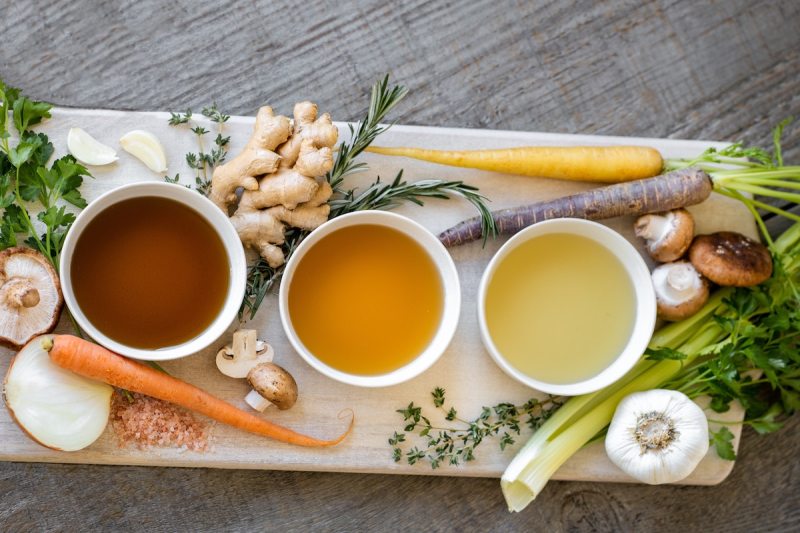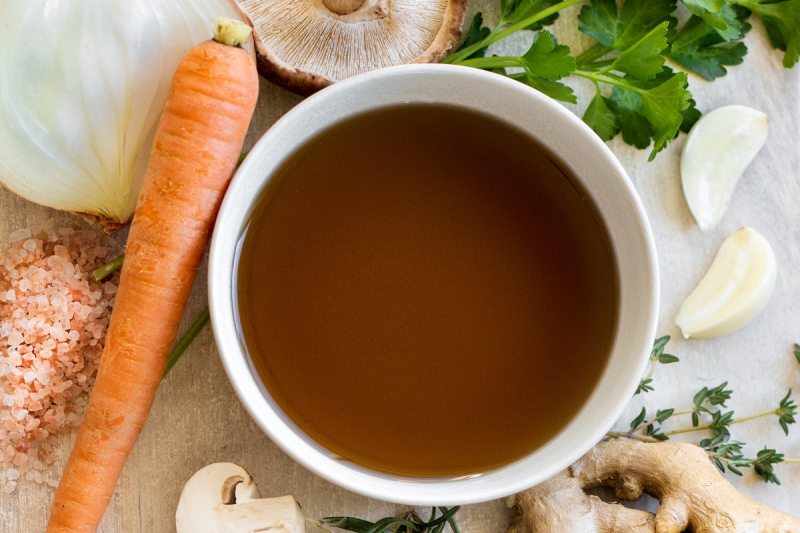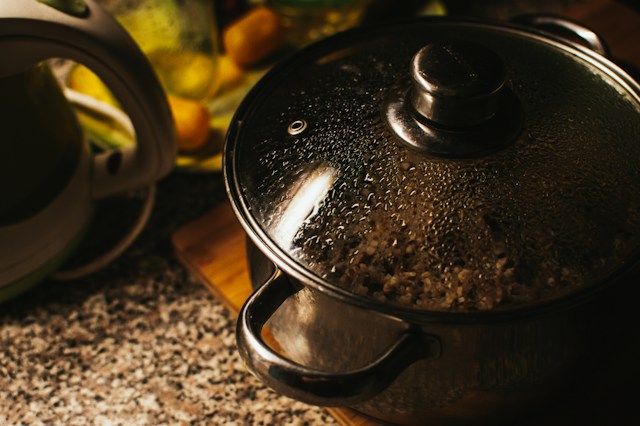Bone broth is a trend that lasted much longer than expected. It’s a nourishing, comforting, drinkable soup that has a lot of nutrition with minimal calories. It’s popular for ideas like the bone broth diet, a type of intermittent fast where you can drink plenty of bone broth on fast days.
As a nutritionist, I am a fan of bone broth and recommend it to my clients who are looking for an easy way to get in more protein and nutrients. If you are intrigued by bone broth, you probably want to know how to make bone broth for yourself because it can be quite costly to purchase pre-made. In this article, we’ll tell you everything you need to know to make your own bone broth, from ingredients and methods to several variations. Let’s go!
What is bone broth?

Ordinary broth, like chicken broth, is typically made from meat instead of bones. Stock is made with both meat and bones, and both broth and stock are simmered for a few hours. Bone broth, on the other hand, is simmered for a very long time to really extract all the flavor and nutrition out of the bones. No meat is included since it would completely fall apart after simmering for so long (typically 12 hours).
What are the benefits of drinking bone broth?

Strengthens bones, joints, and skin
Collagen is a key component of bones, joints, and skin. Since bone broth is made from bones and joints, it has plenty of collagen and can help keep your body supplied with it. It also contains high amounts of the two amino acids that create collagen, which are called glycine and proline, so your body can create more collagen for itself.
Reduces inflammation
The amino acid glycine, in addition to being an ingredient in collagen production, has also been shown to reduce inflammation. Glycine has been proven to “decrease pro-inflammatory cytokines [a class of compounds that cause inflammation] and the concentration of free fatty acids, to improve the insulin response, and to mediate other changes.” Plus, glycine triggers your liver to detox, releasing the toxins it stores so they can be removed from the body.
Improves gut health
Along with the other amino acids found in bone broth, it also contains glutamine, an amino acid that reduces damage to your intestinal lining and improves your gut health. It also encourages your digestive system to produce more enzymes, tiny digestive machines that break molecules apart so you can digest them. The more digestive enzymes you have, the easier it is to digest complex molecules.
What ingredients do you need for bone broth?

The central ingredients for bone broth are bones and water, and you can make bone broth with only of those. You don’t need precise amounts; use just enough water to cover the bones. Most people choose beef or chicken bones. It’s possible to use a hambone or other pork bones, but it’s unusual.
For a much better broth, you’ll need vegetables: onions, carrots, garlic, celery, and possibly turnips. You should also include herbs, like bay leaves, parsley, peppercorns, rosemary, sage, and thyme. Vegetables and herbs aren’t technically necessary for a very minimal bone broth, but trust me, you want to include them.
How to make bone broth

Before starting, you can “blanch” the bones, which means boiling them in water for about 15 minutes and then draining them. This step removes any blood or impurities and gives you a clearer, cleaner broth; it’s more important for beef bones than chicken bones.
Some people also roast the bones and vegetables before making them into broth for a richer, fuller flavor. If you do this, you don’t need to change the simmering time. The goal of simmering is to impart the flavor into the water, and that will take the same amount of time whether they’ve been previously cooked or not.
After those optional steps (if you choose to do any of them), place all the ingredients into the pot you’re going to use — the bones, vegetables, herbs, and so on. Fill it up with enough water to cover them all, but not very much more. Bring to a low boil for a few minutes and then reduce to a simmer.
On the stovetop, you’ll simmer the broth for 8 to 12 hours. This may need to be divided into multiple days of cooking, with the pot placed in the fridge in between. You can also use a crockpot or slow cooker, which should be simmered for 24 to 48 hours, or even an instant pot for only 2 or 3 hours.
Is making bone broth at home worth it?

Bone broth can take a lot of time to make, but most of that time is just simmering. You can put it on the stove on a weekend morning and leave it there all day, as long as you don’t need to leave the house.
It’s also usually pretty cheap; it’s designed to use up old meat bones you already have, which is free, and many butchers or grocery store meat departments will give you bones for cheap or free if you ask. Vegetables like carrots, celery, and onions aren’t expensive either (although it can be difficult to buy celery in small quantities). The herbs might be the most expensive part of the broth unless you grow your own — it can cost $1 to $3 for a small quantity of fresh herbs.
How much bone broth you get from a batch can vary dramatically, based on how long you simmer it and how concentrated you make it, but it’s probably around 1 quart or 32 ounces. Cheap bone broth is about $3.50 for 32 ounces, but higher-quality brands like Kettle & Fire can be over $7 for only 16 ounces or $14 for 32 ounces. Homemade bone broth is usually better than even the more expensive brands.
If you care about quality over convenience, you should definitely try making your own bone broth. If the idea of checking a pot every hour or two for 12 hours straight makes you want to tear out your own hair, it might be better to find a high-quality brand and stick with it.
Frequently asked questions

What bones are best for bone broth?
The most common type of bones used to make bone broth are the chicken bones from a whole chicken. If you regularly cook whole chickens, this is a great solution. Otherwise, you can store bones from bone-in thighs, drumsticks, or wings in the freezer until you’re ready to make a batch of stock.
Why do I feel weird after drinking bone broth?
Drinking lots of bone broth can cause digestive discomfort, possibly because there are a lot of amino acids. They’re necessary but can be hard to digest. The glycine in bone broth also helps your body detox, which might feel strange for a while as the toxins work their way out.
What should you not put in bone broth?
Avoid starchy vegetables like potatoes, which will make the broth starchy, and leafy vegetables, which will fall apart after simmering for a long time. Some people avoid adding salt to bone broth, but others think salt is important for the taste. It depends on what you want.




